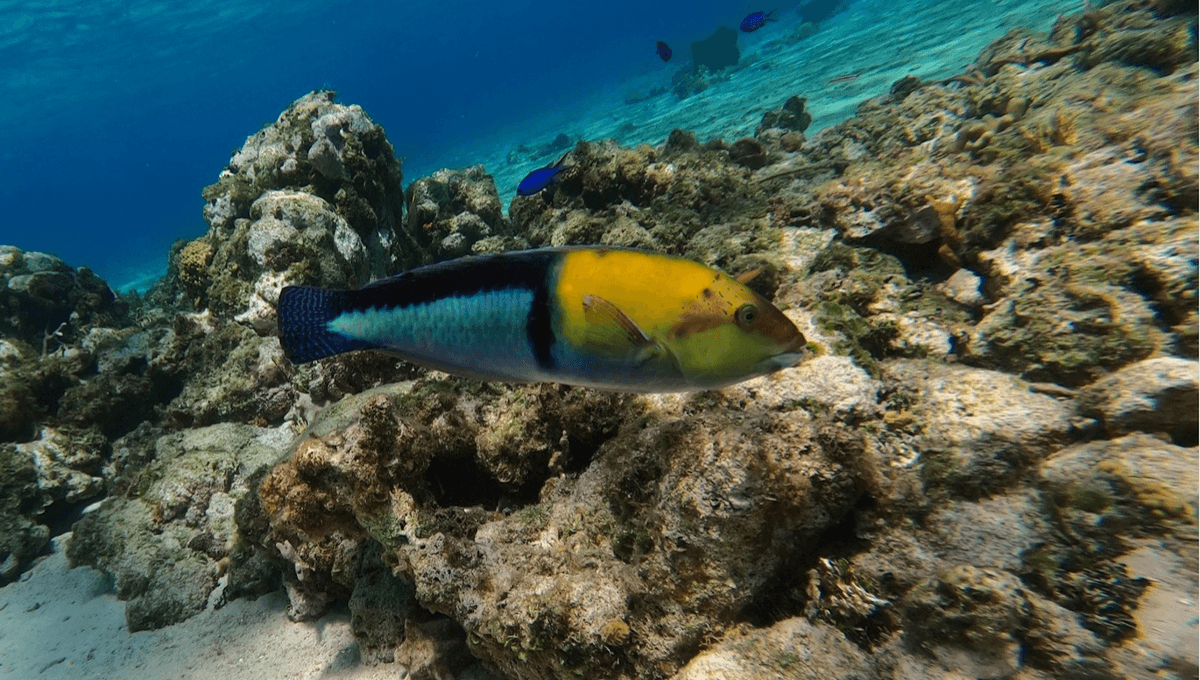
Scuba divers have supplied scientists with 13 film clips and three detailed descriptions of coral reef fish using rocks as anvils to break open hard-shelled sea creatures. The authors of a study analyzing these clips have already learned a lot about fish intelligence in the process, but plenty of questions remain unanswered, and they’d welcome more examples if people have them.
ADVERTISEMENT
In the mid-20th Century, a common definition of humans was that we were the only animal that used tools. When Jane Goodall informed the renowned palaeontologist Dr Louis Leakey of her observations of chimpanzees using tools he famously replied, “Now we must redefine tool, redefine man, or accept chimpanzees as human.”
That seems almost quaint, given the now widespread evidence of monkeys, dolphins, octopuses, and parrots using tools, with some crows having reached masterful complexity.
Still, fish were thought to not be smart enough to join the club, besides most lacking the hands to wield any tool they could invent. That was until Professor Culum Brown of Macquarie University was sent footage of a black spot tusk fish breaking a cockleshell open against a rock.
Brown has been studying the phenomenon since as part of his general thesis that we have underestimated fish intelligence.
Brown and colleagues have tackled this from many angles, observing fish behavior in the lab, putting out tempting items in places where reef fish gather, and scouring the literature. In the last case, they found a few overlooked reports of fishy tool use prior to that influential video, but Brown told IFLScience these were very rare.
Requests for footage have met with more success, however, and a paper analyzing the results reports films of five tool-using fish species, three of them seen for the first time.
ADVERTISEMENT
A blackhear wrasse showing excellent form in the shell-smashing stakes.
In each case, the fish held the prey in its mouth and curved its body before making a quick lateral movement to dash it against a suitable rock.
“Tool use is typically associated with humans, but this behavior is proof that fish are far cleverer than they get credit for,” said lead author Dr Juliette Tariel-Adam in a statement.
ADVERTISEMENT
“We found the behavior is way more widespread in species and geographically than we knew previously,” Brown told IFLScience, “But only in wrasse.”
Wrasse are among the largest fish families, including many that go by that name and others, such as the tusk fish and puddingwife that show some originality in naming. Most live on tropical reefs, but Brown said a few temperate species are also known. One of the first things the authors want to know is what makes wrasse special.
“A lot of their success is due to their jaw morphology and their flexible foraging modes,” Brown told IFLScience. “That’s been tweaked by many species, eating corals, scraping algae off rocks. They do pretty much everything and that has contributed to their success. Maybe tools are part of that as well.”
A wide range of potential prey have been seen being broken on stones, including crabs, sea urchins, and brittle stars. Brown told IFLScience that wrasse often feed on these without needing tools. “There’s probably a size ratio where they can crush the shells with their jaws, but we have not worked out what that is,” Brown said. For smaller wrasse, or larger prey, a convenient rock expands the range.
ADVERTISEMENT
Nevertheless, there is a price to pay for this sort of tool use. For one thing, a great deal of energy is required to give prey the sharp flick that can break them against a stone, and most incidents involved the wrasse having to do so repeatedly. Often, the fish lost control of the shell in the process, although they usually recovered it. In some cases, other fish lay in wait, and ended up gaining the benefit of the tool-user’s efforts. The paper raises the prospect that predators might catch the wrasse while they are distracted, although this has not been observed.
Given the way this little wrasse flicks the sea urchin it is trying to break open to itself and catches it again, its popular name of “slippery dick” seems well chosen.
A particularly important question is whether this trick is innate, or if wrasse have been copying each other since some ancient wrasse genius. “My feeling is it is a mixture of both,” Brown told IFLScience. A master’s student is investigating how well a temperate wrasse species learns from seeing others use tools, but Brown is still waiting for the results. Even among a large population of a single tool-using species presented with a food item ideally suited for being broken this way, most didn’t take up the offer.
ADVERTISEMENT
Brown thinks some fish families, including those that prize intelligence like mosquito fish, haven’t adopted the practice because they’re too small or their prey don’t lend themselves to this treatment. However, resolving why others don’t seem to have developed the capacity may tell us a lot about intelligence generally. “Even among fish, most cognition research is done on tiny species because they’re easier to work with,” Brown told IFLScience; “But it seems there is a real opportunity to learn how smart wrasses are.”
The study is open access in Coral Reefs.
Submissions to future studies can be made through fishtooluse.com
Source Link: Tool Use Is Widespread Among Fish, But Only In One Family